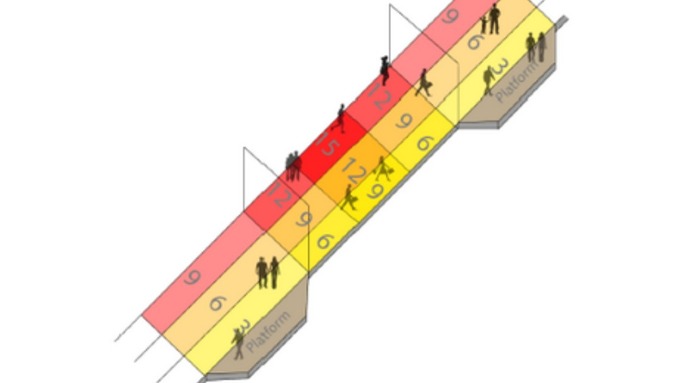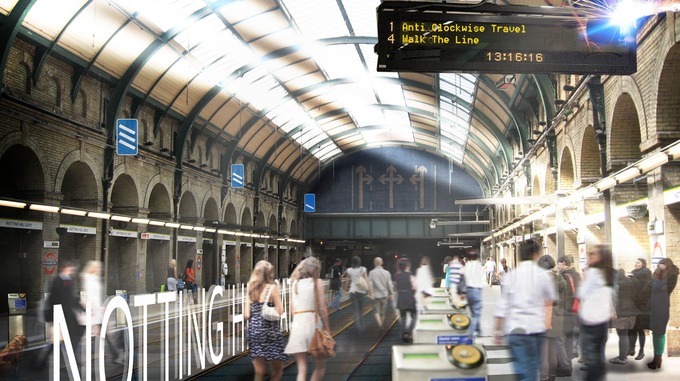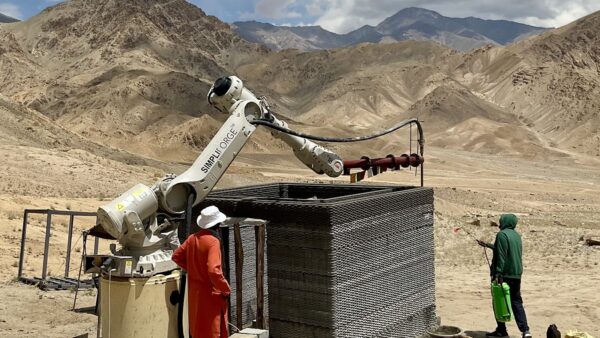London architect NBBJ has designed a huge moving walkway to replace the UK capital’s Circle Line.
The result would be considerably quicker, more enjoyable and healthier journeys– NBBJ
NBBJ say that the “travelator” would reduce delays and provide a better environment for commuters.
The walkway would have three lanes, the speed of which would range from 3-9mph at stops and would increase to 9-15mph between stations.
Shops could be located either side of the travelator.

NBBJ said: “When added to an average walking pace of 3mph, pedestrians would actually move faster on foot than today’s Circle Line trains, which must stop for boarding at each station. Â
“One thing is certain: London requires creative thinking to build a healthy, happy and more livable city for all.”

NBBJ estimate that up to 55,000 more people would be able to use the travelator than the present Circle Line.
The existing line is one London’s busiest, catering to 114 million people each year along 17 miles of track.

Earlier this year NBBJ unveiled designs for a pair of skyscrapers that would not cast a shadow.
Images via NBBJ
Comments
Comments are closed.











Caves of Steel, Written by Isaac Asimov, (I Robot), Published in the UK in 1954 describes at length just such a Walkway,
Science Fiction one day, a practical proposition the next.
I have long thought that this will be the next natural step in pedestrian transportation in London. It is obvious from the ever greater frequency of tube trains that these will morph into some sort of continuous hop-on hop-off system. I really hope this idea gathers momentum.
This concept sounds very much like the Robert Heinlein’s vision in his novel, see below:
After reading this novel Ive often thought it wasn’t such a stupid idea and one day may actually come to fruition !
“The Roads Must Roll” is a 1940 science fiction short story by Robert A. Heinlein. In the late 1960s, it was awarded a retrospective Nebula Award by the Science Fiction Writers of America (SFWA) and published in The Science Fiction Hall of Fame, Volume One, 1929–1964 anthology in 1970.[1]
The story is set in the near future, when “roadtowns” (wide rapidly moving passenger platforms similar to moving sidewalks, but reaching speeds of 100 mph) have replaced highways and railways as the dominant transportation method in the United States.
Heinlein’s themes are technological change and social cohesion. The fictional social movement he calls functionalism (which is unrelated to the real-life sociological theory of the same name), advances the idea that one’s status and level of material reward in a society must and should depend on the functions one performs for that society.
This scheme has not been thought through. Does NBBJ know that the Circle isn’t a closed loop? Not that that necessarily matters, but its tracks also feed 5 District line branches and the Metropolitan which is effectively a regional commuter line, going far beyond London. Do they propose travelatorising them too? Or is Earls Court to be a terminus, and actually cut off from the Circle? And what about heavy maintenance equipment, which needs rails?
‘London needs creative thinking to make it a liveable city’ they say. Thanks, we Londoners never realised.
NBBJ are the guys who thought a building that casts no shadows was a good idea, when shadows play a role in mitigating heat island effect (and give welcome shade). And oh yes, the probably-not-bird friendly ‘invisible skyscraper’ was theirs too.
NBBJ’s ideas could be applied to airports, and maybe ultimately useful for something like Glasgow’s Clockwork Orange railway, but it’s not suitable for a complex system like London’s Underground.
How does one change from the fast travellator to the slowest speed travellator in order to exit at one of the stations ? Does the fast travellator move continuously at 9-15mph and is it possible to move from the 9mph to the slowest speed of 3mph ? Would people in wheelchairs be able to use the system?